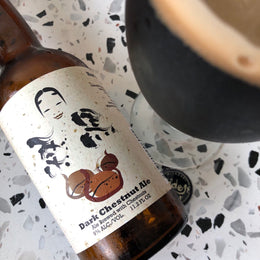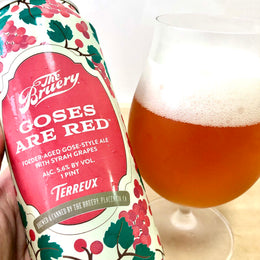Everything About Westmalle, The First Belgian Trappist Brewery; Taste Testing Westmalle Trappist Dubbel & Tripel

Westmalle holds claim to being the first of the Belgian Trappist abbeys to start brewing beers, and whilst keeping their range really short, with just three beers (two of whom are the most widely popular), they've quietly helped to establish the Belgian Trappist style, and have along their centuries of operating even shown quite the innovative streak.
But who is Westmalle?


The Westmalle Abbey.
A Brief History Of Westmalle
Westmalle, or formally known as Brouwerij der Trappisten van Westmalle, is a brewery that belongs to the Belgian Westmalle Abbey, which in turn is part of the Trappist Order. Known as the Trappists (or the Order of Cistercians of the Strict Observance), these are monastic Catholic religious orders that stem from a branching off from the Cistercians. As the story goes, some time in mid-1600's France, an Abbot by the name of Abbot Armand Jean le Bouthillier de Rance had introduced reforms which he believed would reinstate strictness to the monasteries in their religious practices. This became a whole movement congregating at the La Trappe Abbey of Normandy - and thus these monastic orders came to be known as the Trappists. Yet when the French Revolution swept over, the Trappists monks would find themselves fleeing to Belgium, where they would rebuild. Today the Trappist order is worldwide, with 13 across Europe, and in particular just 5 in Belgium, that produce what is thus known as Trappist beers.
These Trappist beers that have now become a core part of the beer tapestry, and are a much beloved style of monastic dark ales. These beers originate as a result of a core part of the monastic traditions for the Trappists being to engage in manual labor, which was one part penitence and another part providing the monastery the ability to be self-sustaining. This meant producing agricultural and handicraft products such as cheese (which they are world famous for as well), beer, and even clothing. These products could be both sold to fund the monastery (and charities) and consumed by the monks and nuns as well. Interestingly other requirements of being a Trappist monk includes minimising speaking (so much so that they've even come up with their own sign language to substitute having to speak), isolating from the world, and also eating meagrely which extends to not consuming four-footed animals.

The people of Westmalle Abbey.
Now there are of course certain guidelines on what can qualify as a Trappist beer as per the International Trappist Association (which monasteries have lost status as from time to time). These guidelines include the beer having to be brewed within the walls of a Trappist monastery (although it can be done by external workers under the supervision of the monks), the brewing having to be of secondary importance to the monastic practice (which has caused issues when the beers became too popular and started to affect the monks' religious practices), and the brewery having to be not a profit-making venture. At this point it might be worth clarifying that there isn't necessarily a fixed Trappist style of beers where it comes to ingredients, process or flavours, but instead the category is defined more strictly by who brews the beers, which is of course the Trappist monks. As such, the best way to classify them are as monastic beers!
And with that it's time to get back to Westmalle. Where we left off, the Trappist monks were fleeing France, with many settling in Belgium - the Westmalle Abbey itself was founded in 1794, and officially became recognised as a Trappist order in 1836. Not long after, in adherence to the Trappist practice of manual labour, Martinus Dom, Westmalle's first Abbot, would get the ball rolling on brewing beer, with the first beer produced in 1836, the same year the Abbey was officiated - they even recorded the date of 10th December 1836 as when that first beer was drunk. Early beer-making was led by Father Bonaventura Hermans and Albericus Kemps, and was a fairly light and sweet beer. This was nevertheless mainly made for the monastery's own consumption and has evolved over time to become what is today known as the Westmalle Extra (identified by a blue label) and is still what's drunk by the monks, only available for purchase at the monastery itself.

Today Westmalle employs a brewery team that helps to carry out the work under the supervision of the monks.
It was in 1856 that Westmalle really got into it with a second beer, this time a strong brown beer, or what's known today as the Dubbel (Dutch for "Double") - this is thus the Westmalle Dubbel (identified by a deep purple label) that is well-distributed around the world today. Sales (done only at the abbey's gate) began with the Dubbel and it would help support the monastery, in fact doing really well, so much that the brewery had to expand, modelling itself after the Trappists of Forges (better known as Chimay, another Belgian Trappist brewery). The recipe has only been tweaked once in its over 150 year history, which was in 1926. The brewery would be upgraded once again 1933, and in 1934, to celebrate the new brewery, Westmalle would produce the first strong pale ale, better known as the Tripel - this was thus the first instance of the Tripel style! The Tripel (identified by its yellow label) has become the calling card for Westmalle, and is now itself a veritable icon of the beer world.
And with that, Westmalle has now been producing beers for over 180 years!
Now let's take a closer look at Westmalle's famous Trappist beers and find out what makes them so unique.

The brewery at Westmalle.
How Westmalle Makes Its Famous Belgian Trappist Ales
The first thing to know about Belgian brewing is that the country is home to some of the longest running active breweries, many over a century old, and thus traditions are big in Belgium. Whilst there are numerous famous styles of beers being brewed in Belgium, the country by and large has an overt historical preference for dark ales over lighter beers, which really only began taking off more recently as a result of the globalisation of Belgian beers being distributed worldwide. And thus it was pretty much standard practice for most historic breweries to boil their beers for extended periods of time in order to achieve that deeper, darker colour, which they associated with what they felt was a good beer that would also have developed stronger flavours. Thus when Westmalle had released its golden coloured Tripel (albeit dark gold), this was considered rather unconventional at the time, but what the hey, the Tripel wasn't even a thing then until Westmalle made it a thing!
And then the other really important thing to know about Belgian beers is that again whilst the styles are diverse, there is broadly an ideal towards the beer being expressive of its yeast character. These yeasts are treated with much reverence and many of which are isolated through centuries of letting nature do its work via spontaneous fermentation, which is what makes Belgian beers so special! Most historic breweries don't use commercially available yeasts which are designed for scale or particular flavours or attributes, they are almost entirely a matter of fortuity! That said, over time, many of these breweries have thus isolated their own yeast strains to ensure consistency. Now this is important when it comes to Westmalle as it was the first Belgian Trappist abbey to start brewing, with the others following suit over time - as a result, of the 5 remaining Belgian Trappist breweries left today, there are only 4 unique yeasts (with Westmalle having shared its yeast with fellow Trappist brewery Westvleteren, and also Achel, which is today no longer a Trappist brewery).

And so with Westmalle, much is done to ensure that its yeasts are made apparent. This is all handled by several brewery staff who are hired externally by the abbey, although they follow the abbey's guidance on brewing. As per the brewing team, the expressiveness of the yeast is encouraged by under-pitching the wort and fermenting at high temperatures, which is said to send the yeast into overdrive. Further to that, a second fermentation is done in bottle to allow the beer to develop even more flavour, and thus for that reason, you'll never find a kegged Westmalle (as that would not allow for a second fermentation). Whilst the beer is kept traditional, the brewing is nevertheless allowed to evolve, so long as it does not affect the flavour of the beer - in one instance, Westmalle had spent 8 years exploring the move from square fermenters to modern conical fermenters (which ran the risk of inhibiting the yeast due to potentially higher pressure). It was only when it was confirmed that there would be no change in the beer's flavour that the move was approved. And in that sense, it could be said that in many subtle and perhaps rather slower moving ways, Westmalle has proven itself to be quite the innovator in the field of Trappist brewing.
Finally, let's talk hops. Unlike the flashy IPAs of the world today, hops whilst still very much important, don't typically feature as much flavour wise where it comes to Trappist beers. This is because the very active yeasts in Trappist beers typically convert much of the sugars into alcohol (which is also why Trappist beers are also usually of a higher proof), and as such too much bitterness from the hops can easily overpower the beer. That said, Westmalle still values the hoppy and herbal element that the hops provides (whilst trying to push down the bitter aspects), and as such uses a combination of about six different hops. The hops are therefore added to the wort during boil in the form of hop cones. Nevertheless this herbal aspect of Westmalle is once again unique amongst its Trappist peers.

The Westmalle Trappist Ales
To introduce Westmalle's beers (which we'll be trying today), we should call to the Holy Trinity, as Westmalle's three beer expressions are often nicknamed and just as well theorised to represent - there's the Westmalle Extra (the lightest), Westmalle Dubbel, and the Westmalle Tripel (the strongest).
As mentioned earlier, the Westmalle Extra is the first beer from the abbey, making it the oldest. The first instance of the Extra was brewed in 1836 when the abbey was formally recognised as a Trappist abbey, and was originally designed to be a light extra barley beer that's meant for the monastery's own consumption, which is still the case today! It is brewed to 4.8% ABV (and has been a "blonde" ever since the last recipe change in the 1920's), and has the lowest ABV of the three. The Westmalle Extra is only available at the abbey itself and is only brewed twice a year, which makes it not nearly as widely enjoyed as the Dubbel and Tripel.
The Westmalle Dubbel emerged soon after in 1856, and got the abbey off to a great start beer-wise, and is perhaps what's responsible for cementing the abbey's work in brewing beers. You could think of the Dubbel as having paid for quite a bit of the abbey's work since it was what allowed for numerous upgrades after it became the first beer sold by the abbey! The Dubbel, which means "Double", is pretty much as the name suggests - two times of everything, which produces a much stronger beer at 7% ABV. It is made with roasted grains of Pilsner, Vienna and Chocolate malts, along with local well water and Saaz and Fuggles hops. Like the Westmalle Extra, the Dubbel also underwent a recipe change in the 1920's (which was the result of the brewery having been destroyed during World War I), after which it included a notable addition of dark candi beet sugar.

And then finally we have the iconic Westmalle Tripel - what is often cited as the first Tripel beer - which was first brewed in 1934 to mark the new brewery facilities. This comes in at 9.5% ABV and is notably a deep gold colour, made from pale and light caramel malts, as well as Styrian Goldings, Tettnang, Saaz and Fuggles hops. Prior to its first official release, it is said that experimentation into producing the Tripel had gone on for years behind the scenes, with the only tweak in the recipe having happened in 1956. They call this the Mother of all Tripels!
And now let's try Westmalle's Trappist beers!
Beer Review: Westmalle Belgian Dubbel

Tasting Notes
Colour: Deep Dark Brown
Aroma: It's rich with caramel, chocolate, some treacle too, with also gentle but just as rich wafts of stewed and dried dates, figs and prunes. Some herbal elements of cooked monkfruit as well, along with more on molasses and licorice. Alittle bit of coffee that envelopes it, with this light roastiness. Some umami savouriness of marmite in there as well, dusted off with clove and cardamom spices. Light doughiness too.
Taste: Good roundedness and richness, yet it still delivers a good balance between the darker and sweeter caramel and treacle, alongside the umami savouriness of marmite and charred burnt ends coming from the roasted malt. Yet it's not heavy and doesn't sink, with the foam also giving a velvety almost cake-y texture. Some cafe latte in there, sprinkled in with some cloves and Christmas cake.
Finish: That combo of darker and sweeter treacle and umami savouriness of marmite carries through the finish, with some lingering cardamom and cloves, also some coffee grounds that stay on beyond the finish.

My Thoughts
The flavours here are rich and earthy, with this delightful velvety coffee cake like texture, where it doesn't sink or get too dense, yet the body hasn't been forsaken - it's by no means thin. The foam adds a nice sweetness and texture to it, almost like that of espresso cream. The body here feels almost like a stout or a porter, whereas its on the aromas that it feels most "Trappist" with the spices and dried and stewed fruits, with a slight yeastiness to it.
This is on the whole really approachable and enjoyable, although certainly alot more easygoing than the Tripel that we're about to try. This is definitely crowd favourite worthy and is a good stepping stone into the world of monastic dark ales. Good balance, restraint and easygoingness.
Beer Review: Westmalle Belgian Tripel

Tasting Notes
Colour: Deep Dark Gold
Aroma: Rich with treacle and caramel, with the clove and cardamom spices coming through immediately, and also this mustiness of sundried goods at a bazaar, of spiced fruit leather, dried persimmons and dried orange peels. At the same time there's this light yet distinct quality of yellow bananas that waft about amidst the aroma. It's really aromatic and quite fruity.
Taste: Medium-bodied here, it's rich and comes off alittle boozy. The body here is filled in with caramel and honey, with a touch of umami marmite, and of course those clove spices, whole white pepper, and then the classic dried citruses of dried persimmons and also fresh oranges and orange blossoms. There's still that fruit paste of figs and prunes, with also this garnish of white florals. It's got good richness, it's plush and rounded, leaning ever so delicately sweet with just a light canvas of caramel on which the dried fruits lay. Some mustiness too, with this gentle yet firm carbonation. Those yellow bananas still.
Finish: More of that honey, caramel and this time a more herbal manuka honey that carries into the finish. Some white pepper, cloves, dried persimmons, monkfruit, that all builds into this clean finish with a light peppery tingle. Some marmite lingers on in this mix of umami savouriness and just a touch of sweetness.

My Thoughts
This definitely upped the ante here, and comes through much stronger and at fuller force. That weight is definitely felt, almost rather muscular, yet this brings with it quite the added complexity. On top of the classic Trappist qualities we found in the Dubbel, the Tripel tops it up with those famous banana and orange esters that start to really come through - they're gentle, bright and elegant, and do require some time to calibrate to look for them, but most certainly they're there and when you find them, it really is quite the delight. There's also this much more apparent mustiness that comes through here, along with a herbal quality that we didn't see before. This all gives the Tripel so much complexity to what is already a considerably powerful brew. This is quite the beast that'll make you go woah!
All that said, it is incredible tasty, yet potent if I might say so. It's very intentional and well-balanced, and you get the clear sense that everything that comes through was deliberately placed as such, it just feels so well synchronised and with such good cadence and power - it's not as if everything rushes you at once, no, in fact it keeps this beautiful cadence and great tempo as it unfolds. Incredibly delicious!
Kanpai!

@111hotpot







